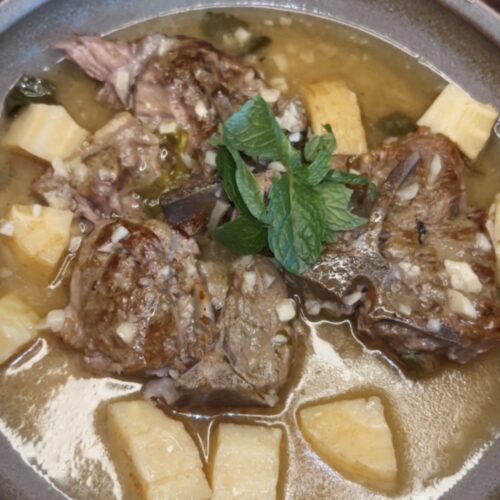Food is one of the most tangible connections we have to the past. While cultures, languages, and civilizations have come and gone, the simple act of cooking has remained a constant throughout history. But how far back can we trace a recipe? The answer takes us over 4,000 years into the heart of ancient Mesopotamia, where the first recorded meals were inscribed on clay tablets.
Among these early culinary records, one dish stands out as one of the oldest written recipes in history—a rich, slow-cooked Babylonian lamb stew, which we now know thanks to the Babylonian Yale Tablets. With ingredients like mutton, garlic, coriander, cumin, flour, and a root vegetable (likely parsnips), this dish offers us a rare glimpse into the diet of one of history’s first great civilizations.
Today, we’re stepping into the kitchens of ancient Babylon, recreating the stew known as Immeru Šuḫutinnu, or “Lamb and Root Stew,” using the techniques and ingredients that the Babylonians may have used thousands of years ago.
The Babylonian Yale Tablets: The First Cookbook
The Yale Culinary Tablets (officially known as Yale Babylonian Collection 4644) are a set of clay tablets inscribed in cuneiform script, dating back to around 1750 BCE, during the reign of King Hammurabi in Babylon. Written in Sumerian, these tablets contain over 35 different recipes, making them the earliest known cookbook in history.

These recipes were not for commoners but rather for temple kitchens, royal feasts, and religious ceremonies. Unlike modern cookbooks, they didn’t include precise measurements or step-by-step instructions but instead listed ingredients and broad techniques—leaving the specifics to the skill of the cook. Among the recorded dishes were various stews, meats, and even a type of flatbread.
One particular dish caught my attention—a lamb stew that called for:
“Mutton is used. Prepare water, add fat. Samidu; coriander; cumin; and kanasu. Assemble all the ingredients in the cooking vessel and sprinkle with crushed garlic. Then blend into the pot suhutinnu and mint.”
Since samidu is thought to be a form of wheat or flour, and suhutinnu translates to a root vegetable (likely parsnips), I’ve adapted the recipe using these interpretations.
The God of Food: Mersu and Ancient Mesopotamian Cuisine
Babylonian cuisine was deeply connected to religion, and food was often prepared as an offering to the gods. One such deity was Mersu, a figure associated with both feasting and agriculture. His name was often linked to dishes made with dates, grains, and meats, which were considered sacred foods in Mesopotamian culture.
Feasting was not just about sustenance—it was a ritual, a way to honor the gods, kings, and the natural cycles of life. Meals like Immeru Šuḫutinnu would have been prepared in temple kitchens, cooked over open fires in large bronze cauldrons, and served during religious festivals or royal banquets.
By recreating this ancient stew, we’re not just making food—we’re reviving a piece of history that was once part of daily life in one of the earliest civilizations on Earth.
What Does It Taste Like?
The slow cooking process transforms the lamb into fall-apart tenderness, infusing it with the rich, spiced flavors of cumin and coriander. The garlic adds depth, while the parsnips bring a natural sweetness that balances out the savory broth. The fresh mint, added toward the end, gives the dish an herbaceous, slightly cooling note, making every bite feel both earthy and refreshing.
This stew isn’t just a meal—it’s history in a bowl. With each bite, you’re tasting something that was once enjoyed by the scribes, priests, and nobility of ancient Babylon.
Recipe: Immeru Šuḫutinnu (Babylonian Lamb & Parsnip Stew)

Babylonian Lamb & Parsnip Stew
Ingredients
- 2 lbs lamb or mutton, cubed
- 2 tbsp olive oil or lamb fat
- 2 tbsp flour samidu, as referenced in the Yale Tablets
- 4 cups water
- 1 tsp cumin
- 1 tsp coriander
- ½ tsp black pepper
- ½ tsp salt
- 4 cloves garlic crushed
- 2 large parsnips peeled and chopped (suhutinnu)
- 1 handful fresh mint leaves
Instructions
- Sear the lamb – In a large pan over medium-high heat, heat olive oil or lamb fat and sear the lamb until browned on all sides. Remove and set aside.
- Make the sauce – In the same pan, reduce heat to medium. Add the flour and mix with the remaining drippings, stirring continuously. Slowly add water, whisking until a smooth sauce forms.
- Assemble the stew – Transfer the lamb and sauce into a slow cooker (or a pot for stovetop cooking). Add the parsnips, garlic, coriander, cumin, black pepper, and salt. Pour in the remaining water, ensuring the ingredients are submerged.
- Slow cook for 6+ hours – Cover and cook on low heat for 6-8 hours, until the lamb is tender and the broth has deepened in flavor.
- Add fresh mint – In the last 30 minutes of cooking, add the fresh mint leaves and stir gently.
- Serve & enjoy – Spoon the stew into bowls and experience the flavors of ancient Babylon!
Notes
- Historical Accuracy vs. Modern Adaptation: The original Babylonian recipe was written in broad terms without specific measurements. This version is adapted using modern cooking techniques while staying true to the historical ingredients and methods.
- Cooking Method Variations: While a slow cooker is ideal for replicating the long, slow simmering process, this stew can also be made in a Dutch oven or traditional clay pot, cooked over low heat for the same duration.
- Serving Suggestions: This stew was likely eaten with flatbreads or barley-based grains, common staples of ancient Mesopotamian diets. To keep it historically inspired, serve with homemade flatbread or a side of cooked barley instead of rice or modern grains.